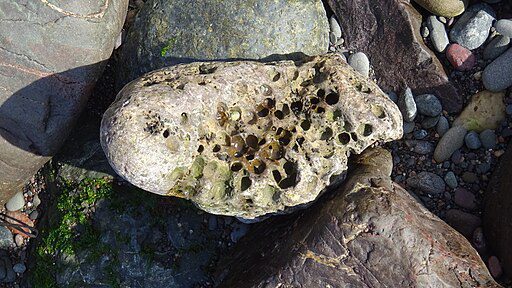Pick your way along the rocky beaches that line many seashores in the UK and, before too long, you’ll most likely come across a hag stone. Often made of flint, these rocks can easily be recognized by their naturally occurring holes. There’s a scientific explanation for how the holes come to be – but that’s only the beginning of the myths, legends, and folklore that surround these unassuming little stones.
What is a hag stone?
You may know hag stones by one of their myriad other names. In English, they are sometimes called adder stones or witch stones; in Welsh, they might be referred to as “Glain Neidr”; Germans call them “Hühnergötter”.
Most hag stones consist of flint, an abundant dark-colored variety of a type of sedimentary rock called chert. The thing that sets hag stones apart from other pebbles you might pick up at the beach is their holes.
These holes can be such perfect circles that it’s hard to believe they occur naturally, but the most frequent explanation is that they are the result of hundreds of years of erosion from the movements of seawater. This erosion can push the fossilized remains of an ancient creature – like a coral – out from the harder surrounding rock, leaving a hole behind.
Some hag stones are the work of a glow-in-the-dark bivalve mollusk called a piddock, sometimes called an angelwing. These critters burrow into rocks as they grow, making themselves tiny caves to sit in while they filter-feed from the surrounding water. You’ll often see rocks with multiple piddock-made holes and crevasses.
Piddock calling cards.
However they originally came into being, hag stones have captivated those who happen across them for centuries, and a wealth of folktales and beliefs have sprung up around them.
What do people believe about hag stones?
Much of the folklore around the mystical properties of hag stones centers around the holes themselves. One theory holds that looking through the hole of a hag stone will allow you to see a witch, who can then conveniently help you out with any illnesses or ailments you might be afflicted with.
Another legend states that the hole of a hag stone is large enough only to allow good fortune to pass through it, while any bad vibes headed your way will be trapped and unable to reach you. Some have suggested that this belief relates to an idea that running water is impervious to magic, and that the hag stones with their holes formed by moving water, therefore, act as shields to protect the bearer.
The connection to the adder, the only venomous snake native to the UK, also goes back centuries. Some of our ancient ancestors believed that the holes in the stones were created by the lapping tongues of snakes, or that the stones were themselves fossilized snakes that had contorted themselves into a ring shape.
This idea appears in the writings of Pliny the Elder, who spoke of so-called “serpents’ eggs” and the high value placed upon them by Druids: “In summer time, numberless snakes become artificially entwined together, and form rings around their bodies with the viscous slime which exudes from their mouths, and with the foam secreted by them.”
The close connection to Druidism also appears in Welsh folklore. According to Marie Trevelyan’s 1909 work Folk-Lore And Folk-Stories of Wales, Druids believed that hag stones were the product of an epic-sounding annual battle of the snakes that took place each spring. The stones were said to have medicinal properties if held or rubbed against an injury. Thanks to their holes, hag stones could be conveniently worn on a chain, so you’d always have one on hand if there was some healing to be done.
Those handy holes mean hag stones can easily be hung in the home or worn as an amulet.
Image credit: Vitalily/Shutterstock.com
Obviously, we can’t guarantee that suspending a hag stone about your person will result in a run of good fortune or protect you if you accidentally tread on an adder, but if you fancy giving it a go there is one tiny word of warning we should give. Under the Coast Protection Act 1949, it’s technically illegal to remove pebbles and rocks from Britain’s beaches, which is probably something to consider before you go absconding with a pocket full of pebbles.
And anyway, many people believe that your lucky hag stone will find you when the time is right, so the best option might be to stop looking altogether.
Source Link: Hag Stones: Holey Rocks With A Magical History
